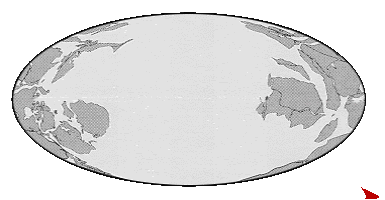In the last post on constraints we decided that the east Pacific and Juan de Fuca ridges were useless in constraining the motions of the Americas. We decided that the Atlantic, Greenland, and Lomonosov ridges were acceptable explanations for the motions of the Americas; and that we simply have no explanation for the motions of Antarctica and Australia, as they are out of scale with the adjacent spreading.
There was clearly a disturbance of the forces acting to move the continents about 80 million years ago.
On the 250mya base map above, Eurasia can be seen to very nearly reverse field, and set a course that rotates continuously to its current position.
North America made about an 80 degree change of course to the west.
South America was the least affected, but changed course modestly. Africa ceased drifting eastward and headed north.
 Antarctica came to a flying stop and reversed field slightly. This projection exaggerates the retrograde motion. Australia slowed and drifted north.
Antarctica came to a flying stop and reversed field slightly. This projection exaggerates the retrograde motion. Australia slowed and drifted north.
Above is the 80mya base map with the 80 to 70mya ocean floor extrusion. Even at 80mya one begins to appreciate the difficulty caused by missing ocean floor. There really does not seem to be anything extraordinary going on here.
The south polar 80mya view tells a different story. The map has been simplified to mere suggestions of the continental shelves to focus on the relation between the ocean spreading and the relevant points. At this scale the blue 70mya Antarctica points are barely visible below and to the right of the red and green 80mya marker. Australia drifted somewhat more down and to the right 80 to 70mya as the separation of the two continents begins.
There is a lot of southern hemisphere and South Polar spreading. India launched about 120mya and its astonishing trajectory is aided by nearly 600 kilometers of spreading between India and Antarctica.
Ridge jumping is a murky concept in tectonics as the discipline has been fixated on the notion of plates. Ridges define plates, and it is very inconvenient when they jump, since real estate formerly on one plate gets transferred to another; or entirely new plates are created. We have zoomed in above and it is easier to see the 70mya Antarctica points behind the 80mya marker. The green is the 90 to 80mya seafloor production, and the red is the 80 to 70.
In a sense, the Pacific ridge has been “jumping” continuously since its inception about 175mya as it moved away from the Pacific Triangle. It continued this habit from 80 to 70mya, except at the very bottom of the image we can see a secondary jump to the other side of the 90 to 80mya ocean floor. We believe this “double” extrusion is the hallmark of the 80mya inflection.
Well behaved ridges extrude into and separate symmetrical bands of older ocean floor. On the 80mya globe this did not happen much. Ridges either jumped to offset or doubled to enclose older ocean floor.
In the next post, we will explore the need to get beyond plates. Ridges must be the focus, and a coherent system of naming the ridges must be developed.














Pingback: Differential Motions of the Continents, Mesozoic and Cenozoic Eras: The 120mya Inflection and Finale | geosciencebigpicture